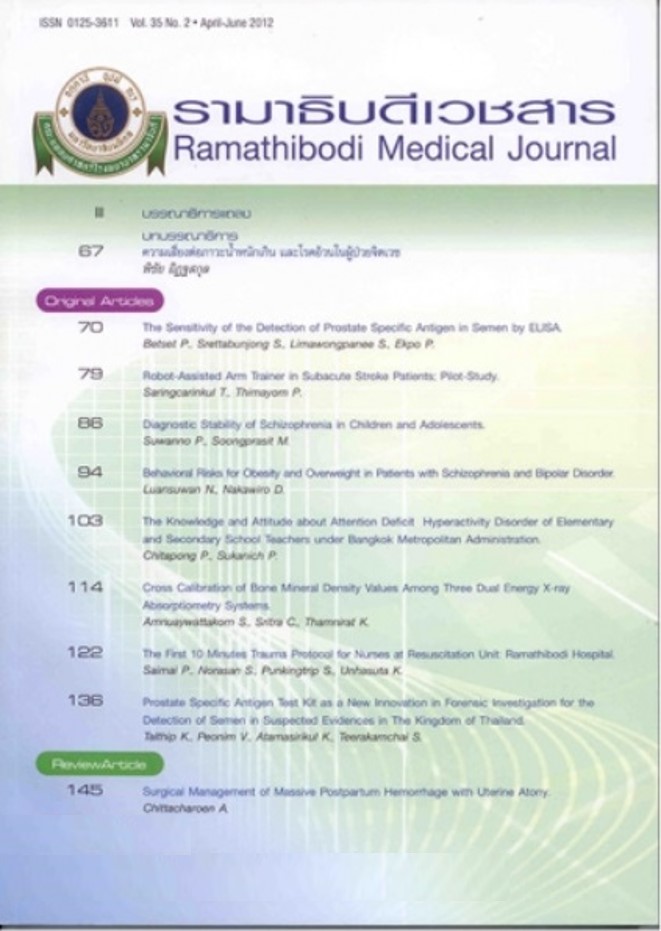The Sensitivity of the Detection of Prostate Specific Antigen in Semen by ELISA
Keywords:
Enzyme-linked immunosorbent assay, Prostate specific antigen, Semen indentification, SensitivityAbstract
Background: In rape cases, examination of biological evidence, especially semen, is very important to identify whether the alleged crime actually happened, resulting in solving the case. Prostate-specific antigen (PSA) is an ideal forensic marker for semen identification, and enzyme-linked immunosorbent assay (ELISA) has been described for many years and found to be still one of the sensitive and efficient methods for PSA detection.
Objective: The purposes of this study were to optimize the assay conditions regarding reagents used and assay time and to determine its sensitivity for the detection of PSA in semen.
Materials and Methods: The semen sample were obtained from 20 consenting healthy Thai male volunteers aged 23-55 years during February – March 2011. All semen samples were stored at -80°C shortly after being secreted from the volunteers’ body and until being used for the analyses. The ELISA method performed in the study followed the previously reported protocol with some optimization. The sensitivity of ELISA in detecting PSA in semen was then studied.
Results: An optimal ELISA condition for the detection of PSA was described with consideration for reagents used and assay time. For sensitivity, the authors found that this method was easily capable of detecting PSA in semen diluted approximately 106 fold with the concentration of 0.56 ± 0.03 ng/ml.
Conclusion: The optimal conditions of an ELISA method for the detection of PSA in semen described was found to be one of the sensitive and efficient methods for the detection of PSA in semen for routine analysis n forensic laboratories, especially in case of a lot of the evidence examined daily, and for further research analysis.
References
Penal Code Amendment Act (No.19) B. E. 2550 (2007). Royal Thai Government Gazettee, 124, 56 a, 1. Bangkok, Thailand: Royal Thai Government; 2007. https://www.ratchakitcha.soc.go.th/DATA/PDF/2550/A/056/1.PDF. Published September 19, 2007.
Mauck CK. Biomarkers of semen exposure. Sex Transm Dis. 2009;36(3 Suppl):S81-3. doi:10.1097/OLQ.0b013e318199413b.
Virkler K, Lednev IK. Analysis of body fluids for forensic purposes: from laboratory testing to non-destructive rapid confirmatory identification at a crime scene. Forensic Sci Int. 2009;188(1-3):1-17. doi:10.1016/j.forsciint.2009.02.013.
Peonim V, Chirachariyavej T, Atamasirikul K, Talthip J. Comparable between rapid one step immunochromatographic assay and ELISA in the detection of prostate specific antigen in vaginal specimens of raped women. J Med Assoc Thai. 2007;90(12):2624-8.
Talthip J, Chirachariyavej T, Peonim AV, Atamasirikul K, Teerakamchai S. An autopsy report case of rape victim by the application of PSA test kit as a new innovation for sexual assault investigation in Thailand. J Med Assoc Thai. 2007;90(2):348-51.
Levine B, Titus JM, Moore K, Fowler D. Use of prostate specific antigen in the identification of semen in postmortem cases. Am J Forensic Med Pathol. 2004;25(4):288-90. doi:10.1097/01.paf.0000136640.06642.f8.
Healy DA, Hayes CJ, Leonard P, McKenna L, O'Kennedy R. Biosensor developments: application to prostate-specific antigen detection. Trends Biotechnol. 2007;25(3):125-31. doi:10.1016/j.tibtech.2007.01.004.
Flocks RH, Urich VC, Patel CA, Opitz JM. Studies on the antigenic properties of prostatic tissue. I. J Urol. 1960;84:134-43. doi:10.1016/s0022-5347(17)65503-4.
Sensabaugh GF. Isolation and characterization of a semen-specific protein from human seminal plasma: a potential new marker for semen identification. J Forensic Sci. 1978;23(1):106-15.
Poyntz FM, Martin PD. Comparison of p30 and acid phosphatase levels in post-coital vaginal swabs from donor and casework studies. Forensic Sci Int. 1984;24(1):17-25. doi:10.1016/0379-0738(84)90147-6.
Johnson ED, Kotowski TM. Detection of prostate specific antigen by ELISA. J Forensic Sci. 1993;38(2):250-8.
Hochmeister MN, Budowle B, Rudin O, Gehrig C, Borer U, Thali M, et al. Evaluation of prostate-specific antigen (PSA) membrane test assays for the forensic identification of seminal fluid. J Forensic Sci. 1999;44(5):1057-60.
Smith DR, Rossi CA, Kijek TM, Henchal EA, Ludwig GV. Comparison of dissociation-enhanced lanthanide fluorescent immunoassays to enzyme-linked immunosorbent assays for detection of staphylococcal enterotoxin B, Yersinia pestis-specific F1 antigen, and Venezuelan equine encephalitis virus. Clin Diagn Lab Immunol. 2001;8(6):1070-5. doi:10.1128/CDLI.8.6.1070-1075.2001.
Nam JM, Thaxton CS, Mirkin CA. Nanoparticle-based bio-bar codes for the ultrasensitive detection of proteins. Science. 2003;301(5641):1884-6. doi:10.1126/science.1088755.
Diamandis EP, Yu H. Nonprostatic sources of prostate-specific antigen. Urol Clin North Am. 1997 ;24(2):275-82. doi:10.1016/S0094-0143(05)70373-6.
Stubbings NA, Newall PJ. An evaluation of gamma-glutamyl transpeptidase (GGT) and p30 determinations for the identification of semen on postcoital vaginal swabs. J Forensic Sci. 1985;30(3):604-14.
Graves HC, Sensabaugh GF, Blake ET. Postcoital detection of a male-specific semen protein. Application to the investigation of rape. N Engl J Med. 1985;312(6):338-43. doi:10.1056/NEJM198502073120603.
Kamenev L, Leclercq M, Francois-Gerard C. An enzyme immunoassay for prostate-specific p30 antigen detection in the postcoital vaginal tract. J Forensic Sci Soc. 1989;29(4):233-41.
Stowell LI, Sharman LE, Hamel K. An enzyme-linked immunosorbent assay (ELISA) for prostate-specific antigen. Forensic Sci Int. 1991;50(1):125-38. doi:10.1016/0379-0738(91)90141-5.













